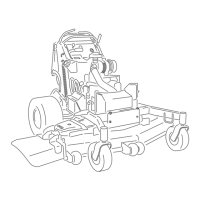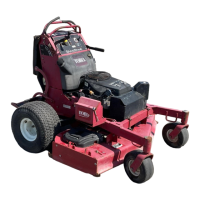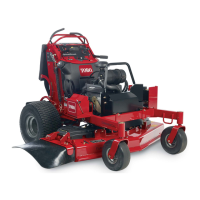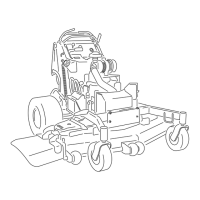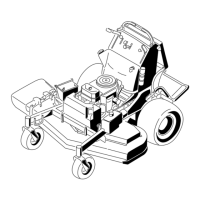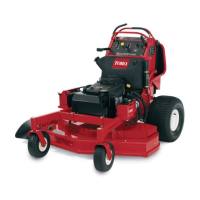Figure75
1.Hydrauliclter
3.Adapter
2.Gasket
8.Cleanupanyspilleduid.
9.Checktheuidinthereservoirandadduidtothe
tankuntilitreachesthecoldbafeofthetank.
Important:Usethespeciedoilorequivalent.
Otheruidscouldcausesystemdamage.
10.Starttheengineandletitrunforabout2minutesto
purgeairfromthesystem.
11.Shutofftheengineandcheckforleaks.
Note:Ifoneorbothwheelsdonotdrive,referto
BleedingtheHydraulicSystem(page53).
12.Checktheuidlevelandadduid,ifrequired.
Important:Donotoverll.
BleedingtheHydraulicSystem
Thetractionsystemisself-bleeding,however,itmaybe
necessarytobleedthesystemifuidischangedorafterwork
isperformedonthesystem.
1.DisengagethePTOandsettheparkingbrake.
2.Shutofftheengineandwaitforallmovingpartsto
stopbeforeleavingtheoperatingposition.
3.Raisetherearofthemachineontojackstandshigh
enoughtoraisethedrivewheelsofftheground.
4.Starttheengineandmovethethrottlecontroltothe
idleposition.
Note:Ifthedrivewheeldoesnotrotate,itispossible
toassistthepurgingofthesystembycarefullyrotating
thetireintheforwarddirection.
5.Checkthehydraulicuidlevelasitdrops,andadduid
asrequiredtomaintaintheproperlevel.
6.Repeatthisprocedurefortheoppositewheel.
CheckingtheHydraulicHoses
ServiceInterval:Every100hours
Checkthehydraulichosesforleaks,loosettings,kinks,loose
mountingsupports,wear,generalweathering,andchemical
deterioration.Makeanynecessaryrepairsbeforeoperating.
Note:Keepareasaroundthehydraulicsystemcleanfrom
grassanddebrisbuildup.
Note:Extendedoperatingtimeathightemperaturesinahot
climatemayleadtodeteriorationofhosesandseals.Inspect
morefrequentlyinahotclimate,andchangethehydraulic
uidandltermorefrequently.
53
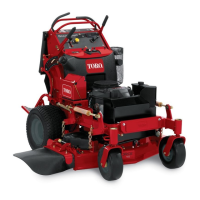
